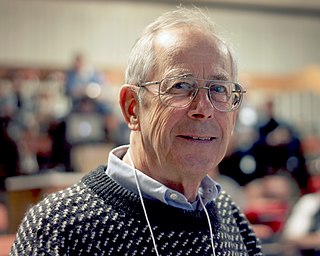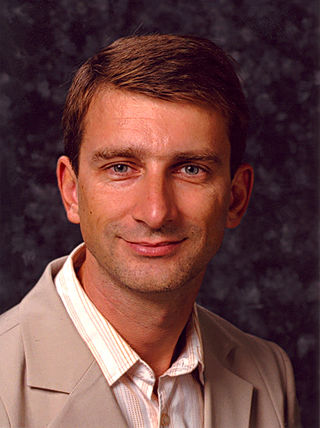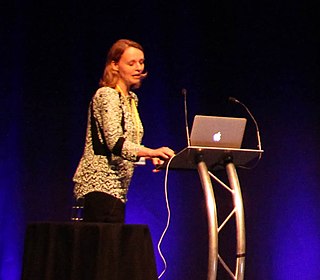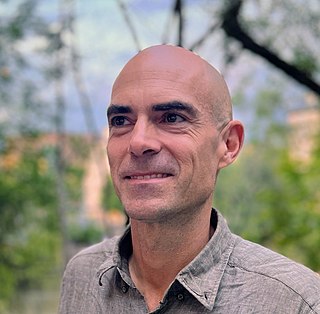Related Research Articles

The cosmic microwave background is microwave radiation that fills all space in the observable universe. It is a remnant that provides an important source of data on the primordial universe. With a standard optical telescope, the background space between stars and galaxies is almost completely dark. However, a sufficiently sensitive radio telescope detects a faint background glow that is almost uniform and is not associated with any star, galaxy, or other object. This glow is strongest in the microwave region of the radio spectrum. The accidental discovery of the CMB in 1965 by American radio astronomers Arno Penzias and Robert Wilson was the culmination of work initiated in the 1940s.

Rashid Alievich Sunyaev is a German, Soviet, and Russian astrophysicist of Tatar descent. He got his MS degree from the Moscow Institute of Physics and Technology (MIPT) in 1966. He became a professor at MIPT in 1974. Sunyaev was the head of the High Energy Astrophysics Department of the Russian Academy of Sciences, and has been chief scientist of the Academy's Space Research Institute since 1992. He has also been a director of the Max Planck Institute for Astrophysics in Garching, Germany since 1996, and Maureen and John Hendricks Distinguished Visiting Professor in the School of Natural Sciences at the Institute for Advanced Study in Princeton since 2010. In February 2022, he signed an open letter from Russian scientists and science journalists condemning Russia's invasion of Ukraine.

Phillip James Edwin Peebles is a Canadian-American astrophysicist, astronomer, and theoretical cosmologist who is currently the Albert Einstein Professor in Science, emeritus, at Princeton University. He is widely regarded as one of the world's leading theoretical cosmologists in the period since 1970, with major theoretical contributions to primordial nucleosynthesis, dark matter, the cosmic microwave background, and structure formation.

The South Pole Telescope (SPT) is a 10-metre (390 in) diameter telescope located at the Amundsen–Scott South Pole Station, Antarctica. The telescope is designed for observations in the microwave, millimeter-wave, and submillimeter-wave regions of the electromagnetic spectrum, with the particular design goal of measuring the faint, diffuse emission from the cosmic microwave background (CMB). The first major survey with the SPT—designed to find distant, massive, clusters of galaxies through their interaction with the CMB, with the goal of constraining the dark energy equation of state—was completed in October 2011. In early 2012, a new camera (SPTpol) was installed on the SPT with even greater sensitivity and the capability to measure the polarization of incoming light. This camera operated from 2012–2016 and was used to make unprecedentedly deep high-resolution maps of hundreds of square degrees of the Southern sky. In 2017, the third-generation camera SPT-3G was installed on the telescope, providing nearly an order-of-magnitude increase in mapping speed over SPTpol.
In physical cosmology, CMBFAST is a computer code, written by Uroš Seljak and Matias Zaldarriaga, for computing the anisotropy of the cosmic microwave background. It was the first efficient program to do so, reducing the time taken to compute the anisotropy from several days to a few minutes by using a novel semi-analytic line-of-sight approach.

George Fitzgerald Smoot III is an American astrophysicist, cosmologist, Nobel laureate, and the second contestant to win the $1 million prize on Are You Smarter than a 5th Grader?. He won the Nobel Prize in Physics in 2006 for his work on the Cosmic Background Explorer with John C. Mather that led to the "discovery of the black body form and anisotropy of the cosmic microwave background radiation".

Charles L. Bennett is an American observational astrophysicist. He is a Bloomberg Distinguished Professor, the Alumni Centennial Professor of Physics and Astronomy and a Gilman Scholar at Johns Hopkins University. He is the Principal Investigator of NASA's highly successful Wilkinson Microwave Anisotropy Probe (WMAP).

Lyman Alexander Page, Jr. is the James S. McDonnell Distinguished University Professor of Physics at Princeton University. He is an expert in observational cosmology and one of the original co-investigators for the Wilkinson Microwave Anisotropy Probe (WMAP) project that made precise observations of the electromagnetic radiation from the Big Bang, known as cosmic microwave background radiation.
The Gruber Prize in Cosmology, established in 2000, is one of three prestigious international awards worth US$500,000 awarded by the Gruber Foundation, a non-profit organization based at Yale University in New Haven, Connecticut.

Uroš Seljak is a Slovenian cosmologist and a professor of astronomy and physics at University of California, Berkeley. He is particularly well-known for his research in cosmology and approximate Bayesian statistical methods.
Marc Kamionkowski is an American theoretical physicist and currently the William R. Kenan, Jr. Professor of Physics and Astronomy at Johns Hopkins University. His research interests include particle physics, dark matter, inflation, the cosmic microwave background and gravitational waves.

Licia Verde is an Italian cosmologist and theoretical physicist and currently ICREA Professor of Physics and Astronomy at the University of Barcelona. Her research interests include large-scale structure, dark matter, dark energy, inflation and the cosmic microwave background.
Michele Limon is an Italian research scientist at the University of Pennsylvania. Limon studied physics at the Università degli Studi di Milano in Milan, Italy and completed his post-doctoral work at the University of California, Berkeley. He has been conducting research for more than 30 years and has experience in the design of ground, balloon and space-based instrumentation. His academic specialties include Astrophysics, Cosmology, Instrumentation Development, and Cryogenics.

Hiranya Vajramani Peiris is a British astrophysicist at the University of Cambridge, where she holds the Professorship of Astrophysics (1909). She is best known for her work on the cosmic microwave background radiation, and interdisciplinary links between cosmology and high-energy physics. She was one of 27 scientists who received the Breakthrough Prize in Fundamental Physics in 2018 for their "detailed maps of the early universe."

Joanna Dunkley is a British astrophysicist and Professor of Physics at Princeton University. She works on the origin of the Universe and the Cosmic microwave background (CMB) using the Atacama Cosmology Telescope, the Simons Observatory and the Large Synoptic Survey Telescope (LSST).
Christopher Michael Hirata is an American cosmologist and astrophysicist.
Shirley Ho is an American astrophysicist and machine learning expert, currently at the Center for Computational Astrophysics at Flatiron Institute in NYC and at the New York University and the Carnegie Mellon University. Ho also has visiting appointment at Princeton University.
Cora Dvorkin is an Argentine physicist, who is a professor at the physics department at Harvard University. Dvorkin is a theoretical cosmologist. Her areas of research are: the nature of dark matter, neutrinos and other light relics, and the physics of the early universe. Dvorkin is the Harvard Representative at the newly NSF-funded Institute for Artificial Intelligence and Fundamental Interactions (IAIFI)'s Board. In 2022, she was voted “favorite professor” by the Harvard senior Class of 2023. She has been awarded the 2019 DOE Early Career award and has been named the "2018 Scientist of the year" by the Harvard Foundation for "Salient Contributions to Physics, Cosmology and STEM Education". She has also been awarded a Radcliffe Institute Fellowship and a Shutzer Professorship at the Radcliffe Institute. In 2018 she was awarded a Star Family Challenge prize for Promising Scientific Research, which supports high-risk, high-impact scientific research at Harvard. In 2020, Dvorkin gave a talk on machine learning applied to the search for dark matter as part of the TEDx Río de la Plata event.

Oliver Zahn is US/German theoretical astrophysicist, data scientist, and entrepreneur, best known for developing algorithms for astrophysical data analysis and widely cited discoveries of phenomena in the history of the Universe. He is also known for his more recent work as founder and CEO of Climax Foods, a California-based biotechnology company modeling dairy and other animal products directly from plant ingredients. Prior to becoming an entrepreneur, Zahn directed UC Berkeley's Center for Cosmological Physics alongside George Smoot and Saul Perlmutter and was Head of Data Science at Google
References
- ↑ "Overview of CMBFAST". NASA . Retrieved September 15, 2023.
- ↑ "Matias Zaldarriaga". MacArthur Foundation . Retrieved September 15, 2023.
- ↑ "Fluctuations in the cosmic microwave background". MIT . Retrieved September 15, 2023.
- ↑ "Matias Zaldarriaga". www.nasonline.org. National Academy of Sciences . Retrieved 2023-09-13.
- ↑ Felicia Lee (2006-09-19). "This Year's MacArthur Awards Cover Many Fields". New York Times .
- ↑ "Natural Sciences Scholars and Alumni Win 2021 AAS Prizes" . Retrieved 2022-02-02.
- ↑ "2021 Gruber Cosmology Prize". gruber.yale.edu. Retrieved 6 May 2021.